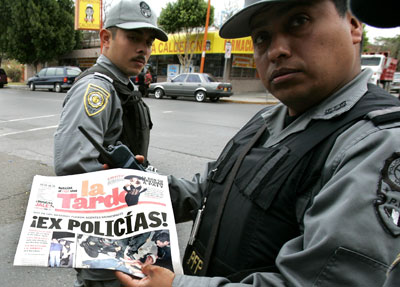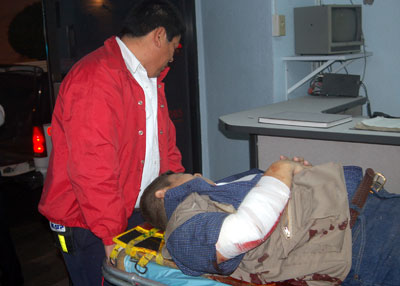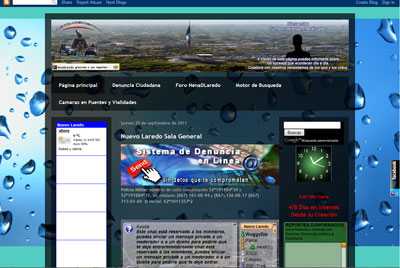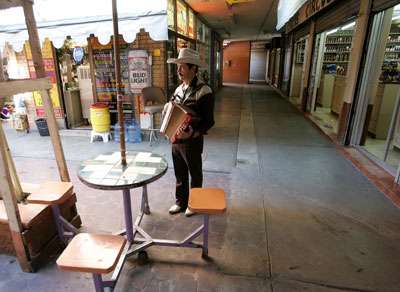You don’t notice it at first. Not with the people seemingly moving as normal on the sidewalks and the happy recorded music blaring across the plaza in front of city hall to announce the annual cowboy parade. No, at first Nuevo Laredo looks like a regular border town, until the military armored car goes by a block away and rotates the heavy machine gun toward the plaza. Are the soldiers just curious? Or do they see something they want to shoot? Who will be hit if they do open fire? Then other images come into focus, like the blocks of closed shops, with for sale signs only on the most recently closed because the owners of the older, more dilapidated shops, have given up even that hope.
U.S. tourists who used to be so important to business don’t come because it is too dangerous. A saleswoman in a nearly empty jewelry shop said, “We have learned to live in a war. But it’s like no one is on our side.” She would only give her first name: Amalia. She was scared to be interviewed because the cartel could be watching. It has lookouts everywhere, she said. So when she spoke about something as dangerous as whether she felt safe she looked down at the floor. People said the police used to work for the cartel, but in June the mayor disbanded the police on the grounds that they were hopelessly corrupted by the Zeta cartel. Last month state officials said one quarter of the state police–2,500 officers–had been fired for failing or refusing to take evaluation tests.
The army came into Nuevo Laredo, and the federal police, to replace city officers. But residents said there aren’t many of them and they only do patrols and don’t investigate crimes. “If someone kills my mother or robs my store maybe there will be a report taken, but it will stop there,” Amalia said.
The war is between the federal police and the army on one side and the Zetas on the other. But the armed men that control this town are the Zetas, people told CPJ. The army fights them, with civilians running for cover, but the Zetas, using death threats often carried out, get what they want from the people, residents told me.
Wars are strange. I’ve covered many. A wartime city can look pretty normal at first. The city of Nablus, on the West Bank, while under the guns of the Israeli army, could bustle with apparent unconcern. Israelis in West Jerusalem, while threatened by Palestinian suicide bombers, took crowded buses to work and ate at sidewalk cafes. People in Sarajevo during the bloody siege took pride in pretending not to notice, even when the death toll was very high. And Nuevo Laredo was having a cowboy parade, even if people lived looking at the floor, like Amalia. That’s the kind of war it is, with two armed sides fighting and the civilians hiding and dying along with them, according to reporters in town.
It’s a world under a Zeta dome, residents said. The cartel ships narcotics north across the border–Texas is across four bridges over the Rio Grande, three in the city and one nearby. This city is at the northern end of one of the most important highways in Mexico and the southern end of one of the main U.S. entry points to Mexico. According to the Laredo Development Foundation, a business group on the Texas side, the crossing here is the busiest anywhere along the U.S.-Mexico border. Last year, there was an average of about 8,000 trucks going north or south each day on the four bridges, according to the Texas Center for Border Economic and Enterprise development. The drugs go north, the guns and cash come south to the Zetas.

The Zetas are the only group that sells drugs in this city of about 360,000. And the only one that openly robs, extorts, and kidnaps. All to great profit, journalists said, since the victims are so afraid and the operations belong to the Zetas alone. Kidnappings and extortion are a big part of the reason the stores are closed, residents said, because businesses can’t afford to make the payoffs anymore.
It seems that all information about the war against them belongs to the Zetas also. Journalists said they cannot report a thing that might upset the Zetas without the serious risk of being killed. And, they say, since the Zetas don’t want anything reported, nothing about them is reported. Not in the papers, or on TV or radio.
So, for the most part, there are no stories about what most affects the people in Nuevo Laredo. There are no stories about the war or the Zetas or the army or the police. There are also no stories about the Zetas’ businesses of retail drug sales in town or their kidnapping and extortion of residents, according to journalists.
In other areas in Mexico where organized crime has its hands around the throat of the press, reporters can often rely on something, perhaps something not accurate, but something from the police or local government or the army. They can usually get some statement with a detail or obfuscation. An official statement allows them to publish at least what the government says. And usually, the criminals don’t complain too much about that. (Often they control the police or the government body issuing the statement in the first place.) But in Nuevo Laredo, reporters said, they normally don’t even get a government press release, not even a return phone call. So having no official statement, and fearful of offending the Zetas if they say something wrong, they say nothing.
At 10:41 on a recent Saturday morning, Jaime Orozco came up to the short step at the door of a restaurant in downtown Nuevo Laredo and stopped his wheelchair. A friend helped him over and he rolled to a table where reporters gather and ordered eggs a la Mexicana, with chopped onions and tomatoes. Asked about the pressures on journalists in the city to hide the truth, he said, “Anyone who dares publish or broadcast the truth about the cartel or the fight against the cartel is a condemned person.” As if the judgment of a man who was paralyzed in a grenade and assault-rifle attack against the city’s main newspaper five years ago needed further emphasis, two other reporters, in unison, ran their fingers across their throats. As a measure of the fear among people here, none of the 12 journalists and six of the seven others I spoke with wanted me to use their names, except Orozco. Even in the jewelry store, when Amalia gave me a name, I doubted it was true.
The motive for the attack on Orozco’s newspaper, El Mañana, was never clear, he said. That left the matter all the more sinister and the impact greater because one ever knew how to guard against another attack. He said, “If you don’t know what you can’t do then you don’t do anything.”

Orozco was shot in February of 2006. Two months later, Dolores García Escamilla, who was a radio reporter covering the crime beat, was murdered in the parking lot of her station as she left work. Reporters in Nuevo Laredo said none of the attacks have been solved. Orozco said that the city’s press was cowed before the attacks but that afterwards even less crime news was covered. Nowadays, those journalists who remain on the crime beat confine themselves to reporting bar fights, stabbings, car accidents or other minor incidents that produce good pictures, but nothing that threatens to go beyond the street.
When Garcia Escamilla was murdered, the Gulf cartel was in charge of Nuevo Laredo and the Zetas were their loyal gunmen. But the Zetas pulled away, first by running their own smuggling and crime networks, according to a senior U.S. official, and then trying to take over all of this state, Tamaulipas, as well as large areas in the rest of Mexico. By early 2010 there were large, sometimes daily gunfights in Tamaulipas, often in the main cities. But the press almost always was forced by the two cartels to not report the battles, reporters have told me. There’s a lull now, or maybe the fight’s over. Nuevo Laredo is under Zeta control, and the Zetas always had a reputation for more violence and less tolerance for the press than the Gulf cartel, according to reporters here. That meant that as bad as it had been, things got much worse, journalists said. Now there’s no room for movement or mistakes.
In this vacuum, ordinary people began to provide their own kind of news, beginning about two years ago, according to reporters. It started as telephone trees where friends and family members warned one another about rumors of gunfights near schools. Usually, reporters said, the rumors were wrong and people panicked and rushed to take their children out of school because of false alarms. But because there were often real gunfights in the city between the army and the Zetas that were never reported in the press, people were ready for the worst. The “news” soon transferred to social media like Twitter and Facebook, but did not improve in reliability, according to the reporters. However, they said, people learned not to react so quickly. Then, a little over a year ago, according to journalists, a website appeared to which residents began posting their warnings. It is Nuevo Laredo en Vivo (Nuevo Laredo Live). At some point — when is a matter of discussion, but probably in the last few months — its content evolved from the usual warnings to also being the place where residents would anonymously post complaints about criminal activity. That’s when everything changed, because, journalists told me, it became a threat to the Zeta cartel. For instance, people were afraid to reveal themselves by telling the authorities about suspected Zeta safe houses–where they might be holding kidnapping victims– or places where Zeta gunmen were living or where Zetas were selling drugs, but an anonymous post on the Nuevo Laredo Live website seemed safe. In a city where the police had all been fired, and where the press could not do its job, the website became the way citizens could report the Zetas to the Army and the federal police, which, however ineptly, may be trying to replace the local police.
In fact, the website has the feel of belonging to the federal government, and many reporters said they believe it does. There are logos and phone numbers of the army and navy and the federal police all over the site, with pleas to anonymously report suspicions either through text messages, phone calls, or emails. Still, no one I spoke with could point with certainty to who is behind the website. The Mexican Ministry of Defense would not comment on whether the military was involved with the website.

But it does seem to be really angering the Zetas. On September 13,the mutilated bodies of a man and a woman hanging from a bridge in Nuevo Laredo were found with a note apparently signed by the cartel that warned against reporting on social media, according to news reports. The victims have not been identified publicly and there is no known connection between them and Nuevo Laredo Live, but that may be beside the point. The Zetas may have been only trying to terrorize, using victims they killed for other reasons.
But then there was the next step. For the first time, CPJ found that someone was murdered directly for posting on social media. On September 25, the decapitated body of a woman was left in the city with what seemed to be another note from the cartel. Gruesomely, her head was left nearby with headphones, close to a computer keyboard. The message read in part, “O.K Nuevo Laredo Live and social media, I am the Girl from Laredo and I am here because of my reports and yours.”
Local journalists told me the victim was María Elizabeth Macías Castro, 39, who they said helped moderate the Nuevo Laredo Live site using the nickname La NenaDLaredo (The Girl from Laredo). They said her family has now fled to Texas. I couldn’t find the family to corroborate her association with the website, nor could I find anyone associated with the site. But as if to substantiate what the journalists said, the site ran a eulogy for her and now has a forum in her name. Several years ago, Macías worked at El Mañana, the paper where Jaime Orozco was paralyzed in an attack, journalists said. And, they said, when she was murdered she was working for another local paper, Primera Hora. At both papers she may have very occasionally written stories, but her main jobs were on the administrative side, they said. Neither paper would comment about her.
There was a fourth murder. An unidentified man was left, decapitated, on November 9 at the same place Macías´ body was left. Journalists said there was another message apparently from the Zetas near the body saying the man had been killed for posting on social networks. Nuevo Laredo Live, however, denied that the victim was a contributor, according to a story in the on-line newspaper Animal Politico. In other words, once again, the Zetas could have used a victim killed for some other reason to scare people away from Nuevo Laredo Live.
Normally homicides are investigated by the state, but the spokesman for the Tamauplipas state Attorney General’s office, Rubén Darío Ríos López, said he had no information on these four cases because they had been taken over by the regional office of the federal attorney general. López said he didn’t know why. A spokesman for the regional attorney general’s office, who would not give his name, said there was never federal involvement in the investigations. So, it seems there is no investigation at all.
The test now is whether the killings have scared away anonymous posts. Will people in Nuevo Laredo once again be without any voice at all? For the moment it doesn’t seem so. Several journalists said they thought the army might be beginning to do better against the Zetas and that tips from Nuevo Laredo Live could be helping. But then since reporters don’t dare investigate even something as basic as whether a tip led to an arrest, they can’t be sure – it’s only an opinion. Today, there are still reports of crimes or suspicious events going up on Nuevo Laredo Live. We’ll never know if there are fewer reports than there would have been without the deaths.
